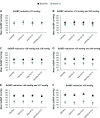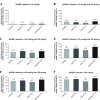The TRINITY Study: distribution of systolic blood pressure reductions
- PMID: 23901293
- PMCID: PMC3724275
- DOI: 10.2147/IBPC.S45450
The TRINITY Study: distribution of systolic blood pressure reductions
Abstract
Background: Elevated systolic blood pressure is more difficult to control than elevated diastolic blood pressure. The objective of this prespecified analysis of the Triple Therapy with Olmesartan Medoxomil, Amlodipine, and Hydrochlorothiazide in Hypertensive Patients Study (TRINITY) was to compare the efficacy of olmesartan medoxomil (OM) 40 mg, amlodipine besylate (AML) 10 mg, and hydrochlorothiazide (HCTZ) 25 mg triple-combination treatment with the component dual-combination treatments in reducing elevated seated systolic blood pressure (SeSBP).
Methods: The 12-week TRINITY study randomized participants to either one of the three component dual-combination treatments (OM 40 mg/AML 10 mg, OM 40 mg/HCTZ 25 mg, or AML 10 mg/HCTZ 25 mg) or the triple-combination treatment. The primary outcome of this analysis was the categorical distribution of SeSBP reductions at week 12 from baseline with OM 40 mg/AML 10 mg/HCTZ 25 mg versus the dual-combination treatments.
Results: SeSBP reductions >50 mmHg were seen in 24.4% of participants receiving triple-combination treatment versus 8.1%-15.8% receiving dual-combination treatment. More participants receiving triple-combination treatment achieved the SeSBP target of <140 mmHg (73.6% versus 51.3%-58.8%; P < 0.001) and the seated blood pressure target of <140/90 mmHg (69.9% versus 41.1%-53.4%; P < 0.001). Prevalence and severity of adverse events were similar in all treatment groups.
Conclusion: Treatment with OM 40 mg/AML 10 mg/HCTZ 25 mg was well tolerated and more effective in reducing SeSBP than the dual-combination treatments.
Keywords: TRINITY; angiotensin receptors; calcium channel blockers; hypertension; olmesartan; thiazide diuretics.
Figures





References
-
- Go AS, Mozaffarian D, Roger VL, et al. American Heart Association Statistics Committee and Stroke Statistics Subcommittee Executive summary: heart disease and stroke statistics – 2013 update: a report from the American Heart Association. Circulation. 2013;127(1):143–152. - PubMed
-
- Chobanian AV, Bakris GL, Black HR, et al. Joint National Committee on Prevention, Detection, Evaluation, and Treatment of High Blood Pressure, National Heart, Lung, and Blood Institute. National High Blood Pressure Education Program Coordinating Committee Seventh report of the Joint National Committee on Prevention, Detection, Evaluation, and Treatment of High Blood Pressure. Hypertension. 2003;42(6):1206–1252. - PubMed
-
- Staessen JA, Gasowski J, Wang JG, et al. Risks of untreated and treated isolated systolic hypertension in the elderly: meta-analysis of outcome trials [published correction appears in Lancet. 2001;357(9257):724] Lancet. 2000;355(9207):865–872. - PubMed
-
- Wright JD, Hughes JP, Ostchega Y, Yoon SS, Nwankwo T. Mean systolic and diastolic blood pressure in adults aged 18 and over in the United States, 2001–2008. Natl Health Stat Report. 2011;(35):1–22. 24. - PubMed
-
- Franklin SS, Jacobs MJ, Wong ND, L’Italien GJ, Lapuerta P. Predominance of isolated systolic hypertension among middle-aged and elderly US hypertensives: analysis based on National Health and Nutrition Examination Survey (NHANES) III. Hypertension. 2001;37(3):869–874. - PubMed
LinkOut - more resources
Full Text Sources
Other Literature Sources

